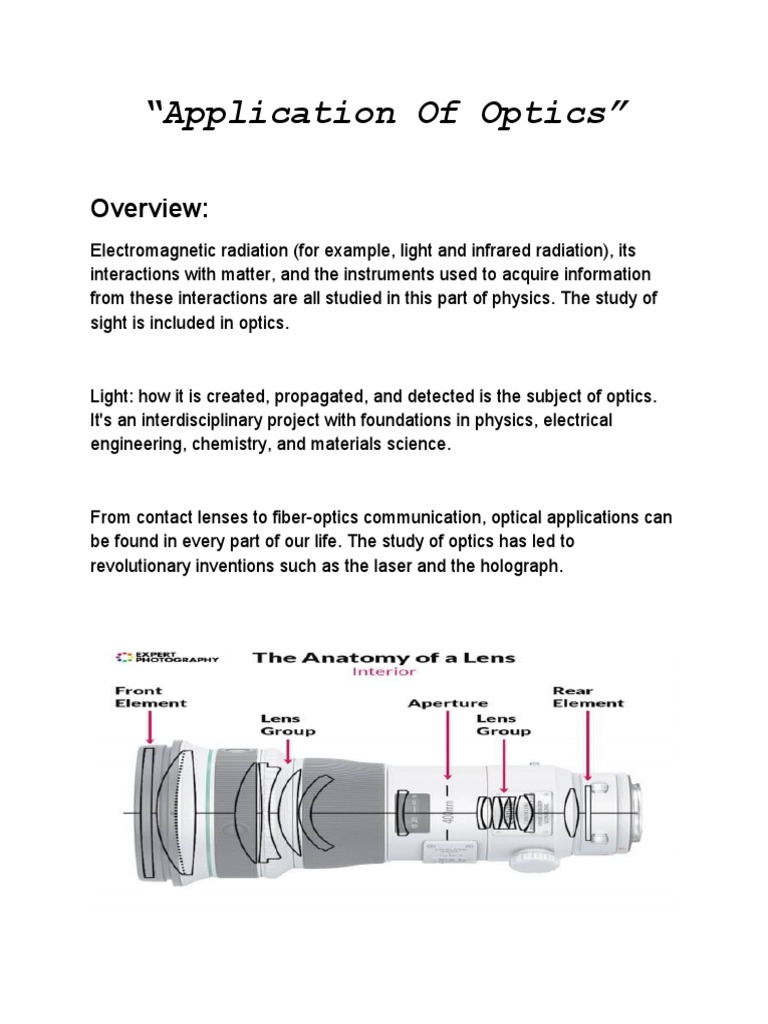Optics, a pivotal branch of physics, has transcended its classical boundaries, morphing into an interdisciplinary field that intersects with numerous scientific and engineering domains. This article elucidates the contemporary landscape of optics research fields and applications, ranging from the fundamental principles of light to avant-garde technological advancements.
The spectrum of current optics research is remarkably expansive. It encapsulates various subfields such as geometric optics, physical optics, quantum optics, nonlinear optics, optical engineering, and biophotonics. Each of these domains contributes uniquely to our understanding and application of light in diverse environments.
1. Geometric Optics
Geometric optics, grounded in the study of light propagation and the principles of reflection and refraction, continues to be an area of significant exploration. Researchers are delving into the design and optimization of optical systems, enhancing lenses, mirrors, and other devices that manipulate light. The development of advanced computational techniques, such as ray tracing, facilitates the accurate prediction of light behavior in complex optical systems. Applications in this domain are ubiquitous, ranging from simple eyeglasses to sophisticated astronomical telescopes.
2. Physical Optics
The realm of physical optics has burgeoned, driven by advances in experimental methodologies. Examining phenomena such as diffraction, interference, and polarization, it unravels the wave nature of light. Research in this area explores the intricate details of light-matter interactions, paving the way for innovations in laser technology and optical materials. For instance, the development of photonic crystals has revolutionized the field, enabling the manipulation of light at the micro- and nanoscales. This has significant implications for telecommunications and the production of energy-efficient light sources, such as LEDs.
3. Quantum Optics
Quantum optics stands at the forefront of modern research, intertwining with the principles of quantum mechanics to investigate the dual particle-wave behavior of photons. This dynamic field has implications that extend beyond fundamental physics; it heralds advancements in quantum computing and secure communication through the utilization of quantum entanglement and superposition. Researchers are currently striving to harness these principles to develop quantum networks, which promise to revolutionize information technology by facilitating ultra-secure data transmission.
4. Nonlinear Optics
Nonlinear optics, characterized by the interaction of light with matter at high intensities, explores phenomena that arise when the response of the medium is nonlinear to the electromagnetic field. This field has been crucial in developing high-energy lasers and novel optical materials. Optical solitons, which maintain their shape while traveling, are a topic of considerable interest that finds applications in telecommunications, particularly in fiber optic networks. The continued exploration of nonlinear interactions also holds promise for creating new frequency sources and enhancing optical switching capabilities.
5. Optical Engineering
Optical engineering integrates principles of optics with engineering practices to design and fabricate various optical devices. Research in this field encompasses the development of optical sensors, imaging systems, and laser systems for industrial applications. The burgeoning field of autonomous vehicles, for example, relies heavily on optics for LiDAR systems that enable real-time obstacle detection and navigation. The integration of optics into consumer electronics, such as smartphones and augmented reality devices, further exemplifies the practical applications of optical engineering.
6. Biophotonics
Biophotonics merges optics with biological sciences, employing optical techniques for medical diagnostics and imaging. Research in this area explores applications such as optical coherence tomography (OCT) and fluorescence imaging, facilitating high-resolution imaging of biological tissues. By harnessing the unique properties of light, biophotonics enables early disease detection and the monitoring of physiological processes. The continuous advancement in laser technologies is propelling research forward, leading to innovative therapeutic techniques, including photodynamic therapy for cancer treatment.
7. Quantum Dots and Nanophotonics
Research in quantum dots and nanophotonics represents the convergence of nanotechnology and optics. Quantum dots, semiconductor nanocrystals, exhibit unique optical properties that can be engineered for specific applications, including displays, solar cells, and bioimaging. By manipulating light at the nanoscale, researchers are unlocking profound potential in information storage and processing, promising compact and highly efficient devices. This area of research also explores the interaction of light with nanoscale materials, opening new avenues for developing metamaterials with tailored optical properties.
8. Optics in Telecommunications
The telecommunications sector has heavily invested in optical technologies, leveraging fiber optic communication for its unparalleled bandwidth capabilities. Research focuses on enhancing signal integrity, increasing transmission rates, and developing innovative multiplexing techniques. The quest for the next generation of optical networks, including optical switch systems and wave division multiplexing, exemplifies the direct application of optics in improving global communication infrastructure. Furthermore, emerging 5G networks will likely incorporate optical solutions to meet the exponentially growing demand for data transmission.
9. Environmental Monitoring and Sensing
Optical technologies are instrumental in environmental monitoring, where they are employed for remote sensing applications, pollution detection, and climate change studies. Sensors utilizing optical techniques can detect minute concentrations of pollutants in the atmosphere and bodies of water, providing critical data for environmental conservation efforts. Research continues to advance in the development of spectroscopic methods that provide real-time monitoring capabilities, enhancing our understanding of environmental dynamics.
In conclusion, the landscape of optics research is vibrant and multifaceted, reflecting its integration into a myriad of scientific and engineering domains. With continuous advancements and innovative applications, the exploration of optics promises to yield significant societal impacts, ultimately enhancing technology, healthcare, environmental sustainability, and communication. The future of optics is luminous, embodying the potential for transformative breakthroughs that will shape our world for generations to come.












